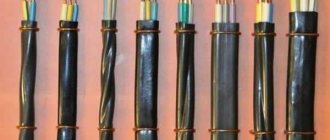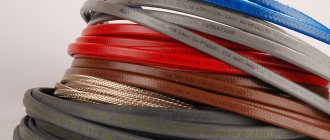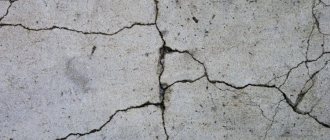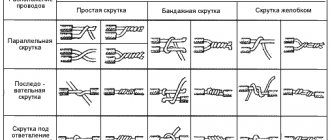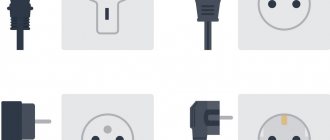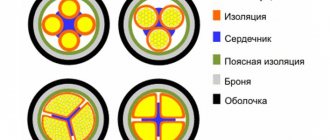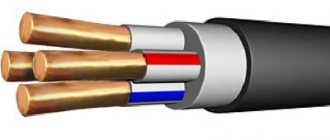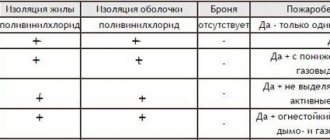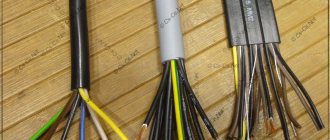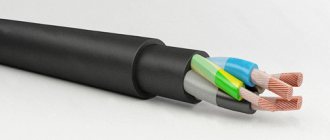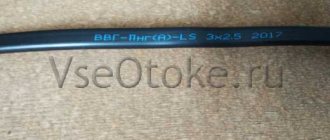Brands and scope
| Cable brand | GOST, TU | Application area |
| KG-HL KG-T KGN KPG KPGS KPGSN | TU 16.K73.05-93 | For connecting mobile mechanisms to electrical networks for rated alternating voltage up to 660 V with a frequency of up to 400 Hz or direct voltage up to 1000 V |
| KOG-1 | TU 16.K73.03-88 | For connection during arc welding of electric holders of welding installations with a rated voltage of 220 V AC with a frequency of 50 Hz or DC |
| KGE | TU 16.K73.02-89 | For connecting excavators and other mobile machinery to electrical networks with a rated voltage of 6 kV AC with a frequency of 50 Hz. |
| KShVGT-10 | TU 16-705.101-79 | For stationary and mobile installation and connection of mobile mechanisms to electrical networks with a rated voltage of 10 kV AC with a frequency of 50 Hz |
Tables
All photos are clickable. Click to enlarge.
Marking of Russian cables:
- Power cables with PVC and rubber insulation.
- Control cables
- Cable with BPI - impregnated paper insulation
Domestic wires and cords:
- Explanation of markings and abbreviations of wires: KSPV, KPSVV, KPSVEV, PNSV, PV-1, PV-3, PVS, ShVVP, PUNP, PUGNP.
- Suspended wires: A, AC, SIP, Ng
- Power, installation wires and connecting cords.
- Installation wires
Marking of foreign cables:
- Power cable
- FROR Italian cables: Italian standard CEI UNEL 35011
- Control cable
- Halogen-free fire-resistant cable
- Cables with cross-linked polyethylene insulation
Foreign wires and cords:
Mounting wires:
Installation wires from foreign manufacturers
Brands and functions of some wires:
Well-known brands and applications of cables:
Areas of application for popular cords:
Designs and operating conditions
| Cable brand | Design | terms of Use |
| Basic (with copper stranded conductors with rubber insulation in a rubber sheath) | For bends with a radius of at least 8 cable diameters, at ambient temperatures from -40 to +50°C when exposed to solar radiation | |
| KG-HL | Using cold climate tires | The same, at ambient temperatures from -60 to +50°C |
| KG-T | With tinned copper wires and rubber for tropical climates | The same, at ambient temperatures from -10 to +55°C, with resistance to mold fungi |
| KGN | In an oil-resistant, flame-retardant shell | When bending with a radius of at least 8 cable diameters, with the possibility of oil getting on the sheath, at an ambient temperature from -30 to +50°C |
| CNG | With highly flexible cores | For bends with a radius of at least 5 cable diameters, at ambient temperatures from -50 to +50°C when exposed to solar radiation |
| CPGS | With highly flexible cores and profiled core | The same, if the cable can be exposed to shock and crushing loads |
KRNB cable
KRNB cable The KRNB cable is intended for connection to various devices and electrical equipment.
It is used for stationary installation only. It can be placed in hostile environments, in the ground and in trenches. When laying the product outdoors, you need to provide it with reliable protection from ultraviolet radiation. Order
Depending on this, you can find the following designations:
The most common options are ANRB, RVGng(A)-FRLS, EPRon AREKVng(A) wires:
- ANRB means that the wire is made of aluminum, has non-flammable and ordinary rubber in its body, and is also covered with armor sheets.
- RVGng(A)-FRLS means the cable is made of fire-resistant rubber with an external PVC coating, without an external protective coating. The abbreviations FR and LS stand for fire resistance and low smoke emission when smoldering, respectively.
- EPRon AREKVng(A). The first word denotes the brand, then each letter is deciphered in turn. Full decoding means that the wire is made of aluminum with a rubber sheath, has a copper screen, armor made of galvanized plates, and a layer of polyvinyl chloride. Also, by the last two letters we can say that the cable is not flame retardant.
Number of cores in cables
| Cable brand | Number of cores | Nominal cross section | ||
| main | grounding | auxiliary | main cores, mm2 | |
| , KG-T, KG-HL, KGN | 1 | — | — | 2,5 — 120 |
| 2 and 3 | — | — | 0,75 — 120 | |
| 2 and 3 | 1 | — | 0,75 — 120 | |
| 2 and 3 | — | 1 | 2,5 — 70 | |
| 2 and 3 | — | 2 | 2,5 — 70 | |
| 4 and 5 | — | — | 1,0 — 25 | |
| CNG | 2 | — | — | 0,75 — 70 |
| 2 and 3 | 1 | — | 0,75 — 70 | |
| KPGS, KPGSN | 3 | 1 | — | 2,5 — 120 |
| 3 | 1 | 1 | 2,5 — 6,0 | |
| 3 | 1 | 2 | 4,0 — 50 | |
| KOG-1 | 1 | — | — | 16 — 150 |
| KGE | 3 | 1 | — | 10 — 150 |
| 3 | 1 | 1 | 10 — 150 | |
| KShVGT-10 | 3 | 3 | — | 25 — 150 |
Core cross-section, mm2
| Main veins | Grounding conductors | Grounding conductors for KSHVGT-10 | Auxiliary cores |
| 0,75 | 0,75 | — | — |
| 1,0 | 1,0 | — | — |
| 1,5 | 1,0 | — | 1,5 |
| 2,5 | 1,5 | — | 1,5 |
| 4,0 | 2,5 | — | 2,5 |
| 6,0 | 4,0 | — | 4,0 |
| 10 | 6,0 | — | 6,0 |
| 16 | 6,0 | — | 6,0 |
| 25 | 10 | 6,0 | 10; 6.0 for KGE |
| 35 | 10 | 6,0 | 10; 6.0 for KGE |
| 50 | 16 | 10 | 10 |
| 70 | 25, 16 for KGE | 10 | 10 |
| 95 | 35, 25 for KGE | 16 | 10 for KGE |
| 120 | 35 | 16 | 10 for KGE |
| 150 | 50 | 25 | 10 for KGE |
The nominal insulation thickness and sheath thickness values for cables of brands , KG-HL, KG-T, KGN, KPG, KPGS, KPGSN are indicated in the table (in this case, large values of sheath thickness refer to cables with a large number of cores). Cable cores of brands , KG-HL, KG-T, KGN, KPG, KPGS, KPGSN must have digital markings or distinctive colors, while green-yellow insulation color is used only for the grounding core. The color of insulation for cables of the KOG-1 and KGE brands is not standardized; in cables of the KShVGT-10 brand, the main cores can have any color except black.
Insulated conductors must be twisted in the right direction, and to ensure operation under given conditions, insulated conductors in cables of the , KGN brands with three main and two auxiliary conductors with a cross-section of 16 mm2 or more, cables of the CPG brand with four conductors of 16 mm2 or more must be twisted around the rubber core, and in cables of the KPGS and KPGSN brands with four cores with a cross-section of 16 mm2 or more, five- and six-core all sections must be twisted around a round or profiled rubber core. In cables of the KShVGT-10 brand, all insulated cores must be twisted with a core made of electrically conductive rubber in the center, and the shell is made of two layers with an inner layer of electrically conductive rubber.
To make cable cutting easier, a layer of synthetic film or other material should be placed over the twisted cores. In cables of the KOG-1 brand and single-core cables of the brand, it is allowed to replace the insulation and sheath with an insulating protective sheath. The nominal thickness of the sheath must be equal to the sum of the thicknesses of the insulation and sheath.
Reference values of outer diameters and weights of cables of the most widely produced standard sizes are indicated in the tables. Taking into account significant tolerances, actual values may differ by 10% down or up.
Decoding abbreviations for cables and wires.
So that you can immediately understand which cable is in front of you, a cable and wire marking system has been introduced. All currently available materials from which cable products are made are designated with certain letters (for example, R - rubber, P - polyethylene, V - PVC (vinyl), etc.), and their position indicates that from this material made - insulation, protection or armor.
Cable marking - what is encrypted in letters and numbers
The first letter in the cable marking is either the letter “A” - aluminum, or a pass. The omission means "copper". So if you see any other letter other than “A” in the first position, it means the conductors are made of copper.
You can also look at information on the topic: Basic abbreviations in electrical engineering and energy
Insulation, armor, protection
First, let's figure out what armor is, what is protection, and what is insulation. When we talk about insulation material, we mean the material used to insulate aluminum or copper conductors. The purpose of this layer is to prevent the cores from shorting out to each other. Dielectric materials are used here: rubber, polyethylene, PVC, fluoroplastic. Once upon a time, paper was also used, but now this type of insulation is almost never used.
Protective shell (inner) -
placed under the armor or outer protective layer so that they do not damage the insulation and also to increase the degree of protection (from water, temperature, mechanical influences). Not always present.
Cable armor
- These are steel strips (galvanized or not) or braided wire (round or flat). Not all cables have this layer. It is needed to increase mechanical strength. Armored cables are used in places where there is a high risk of damage or there are constant loads. They are used for laying in the ground, on poles, under water, etc. No armor is required for internal wiring - there are no critical loads.
Cable protective layer (outer cover)
- This is the outer sheath that protects the armor and/or conductors. Very often the same materials are used here as for insulation, but the material may differ.
All these three shells come after the designation of the core material, that is, these are the second, third and fourth letters (this is if there is a letter “A”; if there is no letter, the wires are copper). Their designation and decoding are in the table.
| Power cable with PVC (vinyl) and rubber insulation: VVG, VVGng, VVGng-LS, AVVG, AVVGng, AVVGng-LS, VBbShv, VBbShng, VBbShng-LS, AVBbShv, AVBbShng, AVBbShng-LS | |
| Abbreviation | Decoding the abbreviation |
| KG | flexible cable |
| A | (first letter) aluminum core, if absent - copper core by default |
| IN | (first (in the absence of A) letter) PVC insulation |
| IN | (second (in the absence of A) letter) PVC sheath |
| G | lack of protective cover “naked” |
| ng | non-flammable |
| L.S. | Low Smoke - with reduced smoke and gas emissions |
| BB | armored cover made of steel strips |
| Shv | outer cover of PVC hose |
| PVS | P - wire; B - insulation and sheath made of PVC plastic; C – connecting. |
| KVVG | K – control; B - PVC insulation; B - sheath made of PVC plastic; G – naked, lack of protective covers. |
| VVG | B - core insulation made of polyvinyl chloride plastic; B - shell made of polyvinyl chloride plastic; G – naked, lack of protective cover. |
| VVG-ng | B - core insulation made of polyvinyl chloride plastic; B - shell made of polyvinyl chloride plastic; G – naked, lack of protective cover; ng - does not spread fire when laid in groups. |
| SHVVP | Ш – cord; B - PVC insulation; B - sheath made of PVC plastic; P – flat. |
| PPV | P – wire; P – flat; B - PVC insulation. |
| Cable with BPI - cable with insulation made of impregnated paper: ASB, ASBl, ASB2l, AABl, SB, SBl, SBG | |
| A | (first letter) aluminum core, if absent - copper core by default |
| AB | aluminum armor |
| SB | (first or second (after A) letter) lead armor |
| l | Mylar ribbon |
| 2l | double lavsan ribbon |
| G | lack of protective cover “naked” |
| Telephone cable: TPpP, TPpep, TPpPz, TPpePz TPpPBbShp, TPpPzBbShp, TPpePzBbShp, TSV, TSVng | |
| T | telephone cable |
| P | polyethylene insulation |
| P | waist insulation - polyamide, polyethylene, polyvinyl chloride or polyethylene terephthalate tapes |
| E | screen |
| P | polyethylene sheath |
| Z | hydrophobic filler |
| Shp | outer cover made of polyethylene hose |
| WITH | station cable |
| Hanging wires: | |
| A | aluminum bare wire |
| AC | aluminum-steel (the word “steel-aluminum” is more often used) bare wire |
| SIP | self-supporting insulated wire |
| Control cable: KVVG, AKVVG, KVVGng, AKVVGng, KVVGng-LS, AKVVGng-LS, KVVGe, AKVVGe, KVVGeng-LS, AKVVGeng-LS, KVBbShv, AKVBbShv, KVBbShng, AKVBbShng, KVBbShng-LS, AKVBbShng- L.S. | |
| TO | (first or second (after A) letter) - control cable except KG - flexible cable |
| E | screen |
| Some cable types are decrypted in a special way: | |
| KSPV | vinyl sheathed transmission cables |
| KPSVV | fire alarm cables, vinyl insulated, vinyl sheathed |
| KPSVEV | fire alarm cables, vinyl insulated, shielded, vinyl sheathed |
| PNSV | heating wire, steel core, vinyl sheath |
| PV-1, PV-3 | vinyl insulated wire. 1, 3 - core flexibility class (the most applicable core flexibility classes for a given type of wire, however, others can also be used) |
| PVS | vinyl sheathed connecting wire |
| SHVVP | Vinyl insulated cord, vinyl sheathed, flat |
| PUNP | universal flat wire |
| PUGNP | universal flat flexible wire |
| Power cable: NYM, NHMH, NYY, NYCY, NYRGY | |
| N | according to VDE |
| Y | PVC |
| H | halogen-free PVC |
| M | installation cable |
| C | copper screen |
| RG | armor |
| Twisted pair data cable: UTP, FTP, S-FTP, S-STP | |
| U | unfoiled (unfoiled, unshielded) |
| F | foiled (foiled, shielded) |
| S | screened (screened with copper wires) |
| SF | common foil screen + common braided screen |
| SS | foil screen for each pair + common braided screen |
| TP | twisted pair - twisted pair |
| Telephone cable and fire alarm cable: JY(St)Y, JH(St)H | |
| J | installation cable |
| Y | PVC |
| (St) | foil screen |
| Halogen-free flame retardant cable: NHXHX FE 180, NHXCHX FE 180 | |
| N | according to VDE |
| HX | stitched rubber |
| C | copper screen |
| FE 180 | the cable retains its properties for a certain time (in this case 180 minutes) in an open flame, under voltage |
| Mounting wires: H05V-K, H07V-K, N07V-K | |
| H | harmonized wire (HAR approval) |
| N | compliance with national standard |
| 05 | rated voltage 300/500 V |
| 07 | rated voltage 450/750 V |
| V | PVC insulation |
| K | flexible core for fixed installation |
| The Italian-made cable has specific designations according to CEI UNEL 35011: FROR | |
| F | corda flessibile - flexible core |
| R | polivinilclorudo – PVC – PVC insulation |
| O | anime riunite per cavo rotondo - round, not flat cable |
| R | polivinilclorudo – PVC – PVC sheath |
| Cables with XLPE insulation: | |
| N | according to VDE |
| Y | PVC |
| 2Y | polyethylene |
| 2X | cross-linked polyethylene |
| S | copper screen |
| (F) | longitudinal sealing |
| (FL) | longitudinal and transverse sealing |
| E | three-core cable |
| R | round steel wire armor |
| J | the presence of a yellow-green vein |
| O | absence of yellow-green vein |
| Control cable: YSLY, LiYCY | |
| Y | PVC |
| SL | control cable |
| Li | stranded conductor according to VDE |
| SAT - from English. satellite - satellite - cable for satellite television | |
Decoding digital values
After the letters, the cable marking contains several numbers. They reflect the operating voltage for which the cable is designed (if there is no number, then it is used for a 220 V network), as well as the number and cross-section of cores. The first is the quantity, separated by the “x” sign is the section. If all the wires are of the same cross-section, there is only one such pair; if there are dedicated wires for the “zero” (they are of a smaller cross-section), the “+” is followed by a second pair of numbers.
Explanation of the ARNBG cable markings and the main symbols that may appear in these positions
This part of cable marking is not so difficult to understand. Let's look at one example. VVG cables are very popular. The meaning of the marking is as follows:
- copper conductors (the letter “A” is missing in the first position);
- the first “B” is vinyl core insulation (PVC),
- the second “B” is a protective shell, the same PVC,
- D - no outer cover.
This cable is considered by many to be optimal for internal wiring in a house or apartment, since it is relatively inexpensive, comes in many versions, and is produced by a large number of manufacturers.
The numbers indicate the number and cross-section of cores
To better understand the digital designations in cable markings, let’s look at several modifications of this cable product:
- VVG 2*2.5 - two conductors with a cross section of 2.5 mm2;
- VVG 3*4 - three conductors with a cross section of 4 mm2;
- VVG 3*4 + 1*2.5 - three working cores with a cross-section of 4 mm2 and one “zero” - with a cross-section of 2.5 mm2.
The numbers are deciphered in the same way in all other cases.
Temperature conditions and GOST
Few people pay attention to the last part of the cable markings. Here the operating mode (minimum temperatures) and the name of GOST or TU according to which this cable is manufactured are indicated.
Temperature data is important for outdoor cable installation. They are especially relevant for regions with low or high temperatures. Therefore, when choosing a cable type, do not forget about this parameter.
Cable marking: examples of decoding
When studying information on labeling, everything seems quite clear, but when trying to apply knowledge in practice, difficulties often arise. The most difficult thing is that some characteristics are displayed by the absence of symbols. With the first position, everything is more or less simple - the “A” is in front - the wires are made of aluminum, if any other letter is copper.
The APvPu2G marking is deciphered as follows:
- A - aluminum conductors;
- Pv - insulation of conductors made of cross-linked polyethylene;
- Pu - protective shell (inner);
- 2G - double waterproofing
Decoding MKESH:
- there is no letter “A” in the first place - copper conductors;
- MK - installation cable
- E - shielded (with aluminum foil);
- Ш - external protection - PVC hose.
As you can see in the example of decoding the MKESH cable, the first position may be the purpose of the cable. Here you can see the following letters:
- G - flexible stranded;
- K - control cable;
- MK - installation cable;
- KSP - transmission systems cable (not power, not used for wiring);
The protective shell and armor may also be missed. They are found in cables that are laid in difficult conditions. That is, confusion may arise here too.
How to navigate? In some cases, by letter. “B” is only the type of armor, “G” is waterproofing, “W” is a protective sheath in the form of an extruded hose. Everything else depends on the situation. But specialists need to study the markings so deeply; a home handyman, basically, needs to know the basic principles, and the specific properties of the cable can be seen in its description. As you can see, cable marking and decoding is not an easy task.
A few more examples of decoding the most popular cables:
VBBShvng:
- there is no letter “A” - copper conductors;
- B - PVC core insulation;
- BB - armor made of two steel strips;
- Shvng - non-flammable external vinyl hose (ng).
AABL:
- A - aluminum conductors;
- A - aluminum shell;
- BL - armor with a backing made of plastic tapes;
KG:
- there is no “A” in front - copper wires;
- K - cable;
- G - naked.
In fact, a CG is just a bundle of copper wires without protective sheaths. Today it is used extremely rarely, but is still found.
Wire marking
The wires are marked in the same way as the cables. The first position also indicates the core material - A - aluminum, and its absence - copper. The second position can be either P (wire), or PP - flat wire, Sh - cord. In the first case, it can be single-core, in the second, it usually consists of two or three (less often, more) cores. Recently a new type has appeared - heating wires. They are designated PN. And the last - third - position with letters is the insulation material. Everything is standard here:
- B - PVC;
- P - polyethylene:
- R - rubber;
- N - nayrite;
- L - cotton shell, varnished;
- O - impregnated cotton braid;
- M - made of oil-resistant rubber;
But this position may contain information about the design or purpose of the wire:
- G - flexible;
- T - for installation in pipes;
- C - connecting;
After the letters there are numbers. This is the number of conductors (first number) and their cross-section (second number).
Wires - P - regular, round, PP - flat
When deciphering the markings, the main thing is to understand where the cable is and where the wire is. After all, the letter “P” in the second position can indicate polyethylene insulation of wires. You can navigate by the number of letters - the marking of wires usually contains 4 letters, and cables - more. Although this is not an obvious sign, it helps in most cases. But the rest of the decoding of wire markings is much easier than that of cable products. Here are some examples:
APPV:
- A - aluminum conductors;
- PP - flat wire;
- B - vinyl insulation;
PNSV:
- letters A no - copper wires;
- PN - heating wire;
- C - steel core, round;
PV. For wires of this brand, a number is written through a dash indicating the number of conductors in the wire (PV-1, PV-3):
- P - wire;
- B - vinyl shell (PVC).
A and AC - uninsulated aluminum wire, AC - twisted.
PR - wire with rubber insulation.
The question often arises: what is the difference between a wire and a cable. Mainly - the number of conductors. The wire most often has one core. Two- and three-core wires differ from cables in that they have only one thin sheath. Cables usually have several of them.
Optical cable marking
Optical cable marking has its own characteristics. The first two letters are OK (optical cable). So there will be no problems with identification. Further, the principle is the same: there is a certain set of notations that encrypt the characteristics. In general, the marking structure after the letters “OK” is as follows:
- Cable laying conditions: G - in the ground
- K - into the sewer
- P - in plastic pipes
- C - self-supporting
- P - suspended
- M - multi-module
- “ng” - non-flammable when laid in groups
- LS - polyethylene, which does not emit halogens, has reduced smoke and gas emissions
- 00 - single-module (no TsSE)
- E1 – single-mode OFF with unshifted dispersion according to ITU-T G.652.B recommendation
Insulation and sheath thicknesses for cables of brands KG, KG-HL, KG-T, KGN, KPG, KPGS, KPGSN, mm
| Nominal cross-section of main cores, mm2 | Insulation | Sheath for single-core cables | Sheath for multi-core cables |
| 0,75 | 0,8 | — | 1,3 — 1,5 |
| 1,0 | 0,8 | — | 1,3 — 1,6 |
| 1,5 | 0,8 | — | 1,5 — 1,8 |
| 2,5 | 0,9 | 1,4 | 1,7 — 2,0 |
| 4,0 | 1,0 | 1,5 | 1,8 — 2,2 |
| 6,0 | 1,0 | 1,6 | 2,0 — 2,5 |
| 10 | 1,2 | 1,8 | 3,1 — 3,6 |
| 16 | 1,2 | 1.9 | 3,3 — 3,9 |
| 25 | 1,4 | 2,0 | 3,6 — 4,4 |
| 35 | 1.4 | 2,2 | 3,6 — 4,5 |
| 50 | 1,6 | 2,4 | 4,5 — 5,0 |
| 70 | 1,6 | 2,6 | 4,8 — 5,0 |
| 95 | 1,8 | 2,8 | 5,0 — 5,3 |
| 120 | 1,8 | 3,0 | 5,0 — 5,3 |
general information
Cable marking makes it possible, when installing electrical networks, to find out such operating parameters of the conductor as core material, thickness, design voltage, functional purpose of the cable, material and flammable characteristics of the insulating sheath, and other features.
The designations “wire” and “cable” are, in principle, synonymous; the difference between them is determined only by the scope of application. Thus, wires are usually used to distribute electrical wiring under light load conditions, and cables are used to conduct electricity from power plants and in highly loaded networks; therefore, they are heavier, as they are equipped with good protection. There is also a category of “cords” - this is a flexible conductor with twisted conductors, used in the design of electrical appliances for mains power. Cords, as a rule, lack overall insulation.
Despite the fact that the marking of wires and cables may have different letter designations in alphabetical order and case, it is always carried out in accordance with the general principle. First comes a description of the functional and design features using letters. For example, PUNP - wire (P) universal (UN) flat, and then digital markings of the number of cores and cross-sectional area of the conductors. Here the decoding of PUNP 3×1.5 means that this flat universal wire consists of three current-carrying wires with a cross-section of 1.5 mm2. The order of letters in the abbreviation depends on the strictly established GOST standard, and the thickness and number of cores must always come after them. After these data there is a designation of the climatic operating conditions (if there are any special features), and then the specifications or GOST according to which the cable products were manufactured.
According to the conditions under which and for what purposes conductors are used, they are divided into:
- power – used when laying electrical wiring;
- control - installed in the wiring that serves to transmit signals;
- control cables – installed in systems and circuits that control the operation of automatic systems;
- radio engineering – used in radio engineering installation.
Colors of cores for cables of brands KG, KG-HL, KG-T, KGN, KPG, KPGS, KPGSN
| Number of cores | Color without grounding conductor | Coloring with grounding conductor |
| 3 | blue, black, brown | green-yellow, blue, brown |
| 4 | blue, black, brown, black or brown | green-yellow, blue, black, brown |
| 5 | blue, black, brown, black or brown, black or brown | green-yellow, blue, black, brown, black or brown |
| 6 | — | green-yellow, black, blue, black, brown, black |
Insulation and sheath thicknesses for KOG-1 cables, mm
| Nominal cross-section of main cores, mm2 | Internal and external screens for core and insulation | Insulation | Belt screen | Shell |
| 10 — 50 | 0,4 | 4,0 | 1,5 | 3,5 |
| 70 — 150 | 0,6 | 4,0 | 2,0 | 4,0 |
What are wire insignia?
The marking of power cables consists of letters indicating the material from which the sheaths, insulation, conductors are made, as well as the type of protection. High voltage cable designations include design features.
Copper conductors are not marked with a special letter in the inscription. Usually the aluminum core is the letter “A”, which is at the beginning of the marking. Then comes the letter that identifies the insulation material. Polyethylene insulation is designated by the letter “P”, polyvinyl chloride is designated by the letter “B”, and rubber insulation is designated by the letter “P”. Next comes a letter indicating the type of protective sheath, namely: the letter “A” is aluminum, the letter “C” is lead, the letter “P” is a polyethylene hose, the letter “B” is a polyvinyl chloride sheath, the rubber sheath is the letter “P” . The last letters indicate the type of cover.
For example, the “SG” brand has a copper core, paper insulation, a lead sheath, and no protective covers. The marking of an oil-filled cable contains the letter “M” (for gas-filled cables – the letter “G”) and a letter indicating the oil pressure characteristics and related features. For example, the “MNS” cable is an oil-filled cable, low pressure, in a lead sheath, which has a protective cover.
Marking of wires and cables is carried out by numbers and letters, according to GOST and TU: GOST 16442-80 and TU16.71-277-98.
Thicknesses of structural elements for cables of the KShVGT-10 brand, mm
| Nominal cross-section of main cores, mm2 | Internal screen along the core | Insulation | External insulation screen | Inner shell | Outer shell |
| 25 — 70 | 0,8 | 6,0 | 1,0 | 3,0 | 5,0 |
| 95 — 150 | 1,2 | 6,0 | 1,0 | 3,0 | 6,0 |
Electrical Requirements
For the period of acceptance and delivery, cables of brands , KG-HL, KG-T, KGN, KPG, KPGS, KPGSN must withstand an alternating voltage test for 5 minutes without immersion in water, and single-core and cables of the KOG-1 brand after being in water are subject to an alternating voltage test 2 .5 kV with a frequency of 50 Hz. Cables of the KGE brand must withstand a voltage test of 15 kV, and cables of the KShVGT-10 brand - 20 kV alternating current with a frequency of 50 Hz for 5 minutes.
The electrical insulation resistance under normal climatic conditions, recalculated per 1 km of cable, upon acceptance and delivery must be at least 50 MΩ, for cables of the KShVGT-10 brand, at least 100 MΩ.
Advantages and disadvantages
Each type of cable from all those considered has its own characteristics, pros and cons.
But in general, their advantages include the following:
- increased flexibility;
- low current conductivity;
- strength and reliability;
- high switching capacity.
Increased elasticity is achieved through the use of a special rubber insulating layer. In addition, the wires can withstand the effects of acids, alkalis, and oil. Moisture is also not a problem. With this insulation, the product can withstand elevated temperatures when a short circuit occurs. But you need to keep in mind that direct sunlight is completely unsuitable.
There are other disadvantages as well. This primarily concerns poor performance in HF networks.
Another disadvantage is the high price. In addition, due to the fact that the veins are rounded, the diameter on the outside is larger than that of those products that have the shape of sectors.
Outer diameters of cables, mm
| Nominal cross-section of main cores, mm2 | Single-core brands, KG-HL, KG-T | With three main conductors and a grounding conductor of brands KG-HL, KG-T, KGN | With three main conductors and a grounding conductor of the CNG brand | With three main conductors and a grounding conductor of brands KPGS, KPGSN | KOG-1 | KGE | KShVGT-10 |
| 0,75 | — | 10 | 10 | — | — | — | — |
| 1,0 | — | 10 | 10 | — | — | — | — |
| 1,5 | — | 11 | 11 | — | — | — | — |
| 2,5 | 7,0 | 13 | 13 | 16 | — | — | — |
| 4,0 | 8,0 | 16 | 16 | 18 | — | — | — |
| 6,0 | 9,0 | 18 | 19 | 22 | — | — | — |
| 10 | 10 | 23 | 24 | 25 | — | 41 | — |
| 16 | 13 | 25 | 28 | 30 | 10 | 44 | — |
| 25 | 15 | 30 | 32 | 34 | 12 | 46 | 67 |
| 35 | 17 | 35 | 38 | 38 | 14 | 50 | 72 |
| 50 | 19 | 42 | 44 | 45 | 16 | 54 | 74 |
| 70 | 22 | 45 | 49 | 49 | 18 | 63 | 79 |
| 95 | 24 | 51 | — | 53 | 20 | 67 | 86 |
| 120 | 27 | 56 | — | 58 | 23 | 72 | 91 |
| 150 | — | — | — | — | 25 | 78 | 97 |
